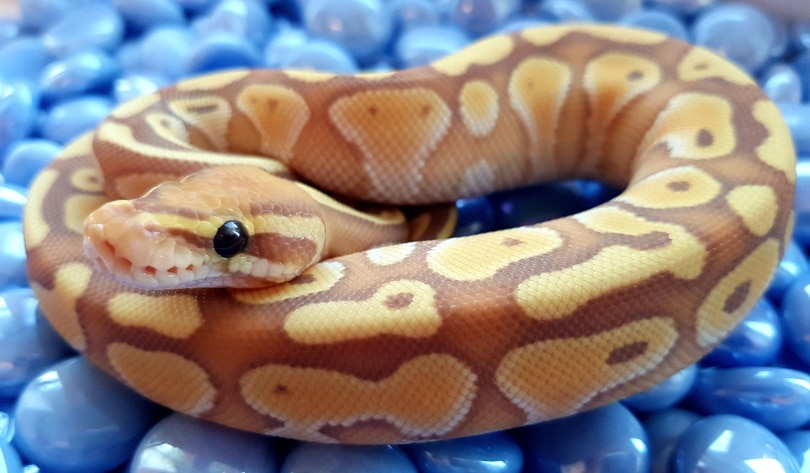

What is the difference between a regular ball python and a lesser ball python? The only real difference between these two animals is the morph color. Ball pythons have more brown and black coloring and the lesser python has a little more yellow and brown color patterns. Lesser ball pythons are actually used as a base morph. This means that they provide genes for many other ball python species with more unique colors. If you’re infatuated with the lesser ball pythons and are dying to learn more about them before bringing one home, you’re in the right place.
Quick Facts about Lesser Ball Python
| Species Name: | Python regius |
| Common Name: | Lesser Ball Python |
| Care Level: | Easy |
| Lifespan: | Up to 30 years |
| Adult Size: | 4 ft. to 6 ft. |
| Diet: | Carnivore |
| Minimum Tank Size: | 30 to 40 gallons |
| Temperature & Humidity
|
Around 80°F and 50% humidity |
Do Lesser Ball Python Make Good Pets?
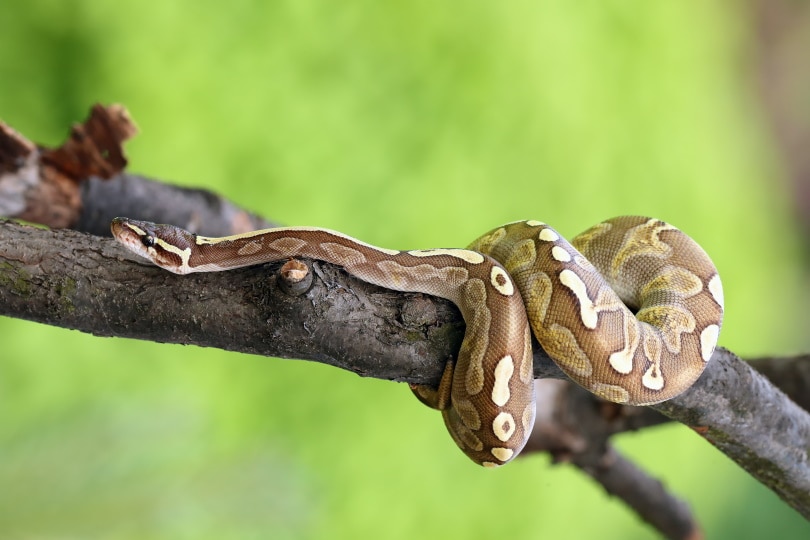
Lesser ball pythons are one of the first pet snakes that most people gravitate towards. Ball pythons are known to be excellent beginner snakes because of their docile personalities. They are also fairly easy to care for, and housing them isn’t too expensive. There are a few requirements that they need in order to be healthy, but maintaining their habitat isn’t hard. These are some of the safest snake options if you’re interested in handling them, and they are where you should start if you don’t have a lot of experience working with reptiles.
Appearance
Lesser ball pythons don’t have a lot of extravagant colors compared to some of the other ball python morphs, but they are a base morph and are a species that has allowed all the other morphs to be created. Lesser ball pythons reach up to 6 feet long as they mature, and the males are usually a bit shorter and lighter than the females. The main difference between a lesser ball python and a regular ball python is in color. Lesser ball pythons have light brown and yellow coloring all over their bodies and bellies. A lot of people mistake their light coloring for the butter python, but those morphs have even lighter coloring than the lesser python.
How to Take Care of Lesser Ball Python
Habitat, Tank Conditions & Setup
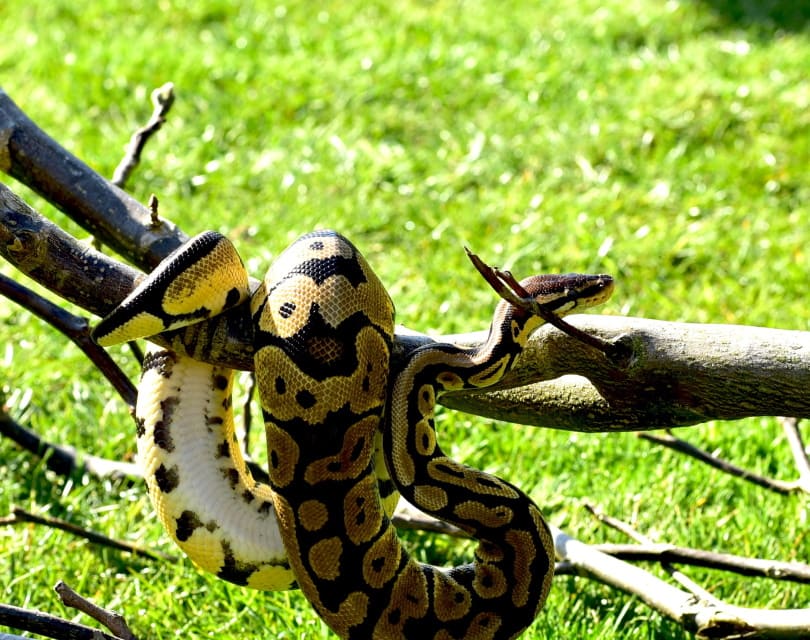
Lesser ball pythons may be easy to care for, but you have to give them a setup that they’re going to be happy inside of if you expect this level of care. The tank, lighting, heat, humidity, and substrate should all be considered before bringing a python home. You want to give them somewhere where they are going to be comfortable so that other issues don’t arise. Without the right conditions, this could cause an assortment of health problems and shedding issues that leave you stuck with a vet bill in order to get them better.
Tank
The tank that you put your lesser ball python in is one of the most important parts of keeping your snake happy. These cages can be as elaborate or as simple as you want, but keeping them clean is absolutely necessary. The more you put in the cage, the harder it is going to be to clean and disinfect everything.
Glass reptile terrariums are the best option for lesser ball pythons. Try not to get one with a screen top since it makes it harder to control the humidity levels inside. You don’t want a tank that is too large or big. They like feeling a little snug, without being overcrowded, in order to help them feel more secure. A 30 or 40-gallon tank is usually adequate for a full-grown ball python.
Spot clean your tank as often as necessary and do a complete removal and deep clean once every month. This includes removing the substrate and all accessories to disinfect them and start fresh. Make sure you have at least one cage hide inside for them to crawl into and feel safe throughout the day.
Lighting
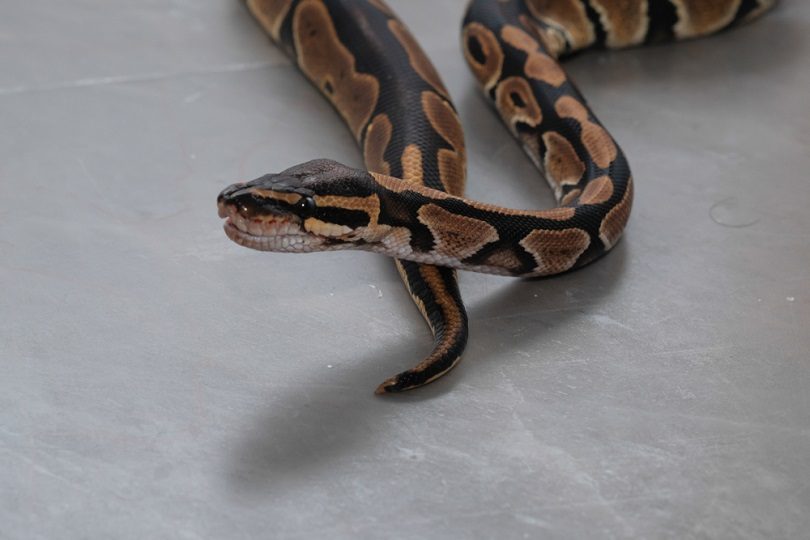
Additional lighting in the cage isn’t usually necessary, and sometimes consistent bright lights could be stressful to your snake. Most people use overhead lighting and keep them on for 12 hours and off for 12 hours.
Heating (Temperature & Humidity)
The temperature and humidity are some of the most critical conditions for you to focus on when caring for a lesser ball python. Give your lesser ball python a temperature range of 80°F to 95°F. Do not let the temperature fall below 75°F. Never guess when controlling the temperature. Instead, buy a thermometer so that you always know exactly how warm it is inside.
Underage heating pads are becoming more and more popular among snake owners, but there is a wide range for you to choose from. Keep a close eye on the humidity levels when the heating pad is on. Pythons enjoy a humidity level between 50% and 60%.
Substrate
If you’re on a budget, newspaper and paper towels are safe options for you to use as substrate in your cage. If you want the cage to look better and feel more like home for your snake, use cypress mulch or orchid bark. These are both great at controlling humidity levels. Don’t use substrate containing cedar since the oils from it are deadly to reptiles.
| Tank Recommendations | |
| Tank Type | 40-gallon glass terrarium |
| Lighting | 12 hours on 12 hours off |
| Heating | Heating pad |
| Best Substrate | Cypress mulch
|
Feeding Your Lesser Ball Python
Lesser ball pythons are strict carnivores, and you should feed them one appropriately sized rodent each week. You don’t want to give them prey that is so large that they can’t swallow it or too small that it doesn’t give them sufficient nutrients. Rat pups or small mice are both good options to feed to your ball python.
Do not handle your lesser ball python for at least 24 hours after you feed them, or they might regurgitate their food. If you don’t want to handle live rodents, you can give them frozen and thawed rodents that are pre-killed. Always observe the feeding because if you leave them alone, then they could injure your snake.
| Diet Summary | |
| Fruits | 0% of diet |
| Insects | 0% of diet |
| Meat | 100% of diet – small-sized rodents |
| Supplements Required | None
|
Keeping Your Lesser Ball Python Healthy
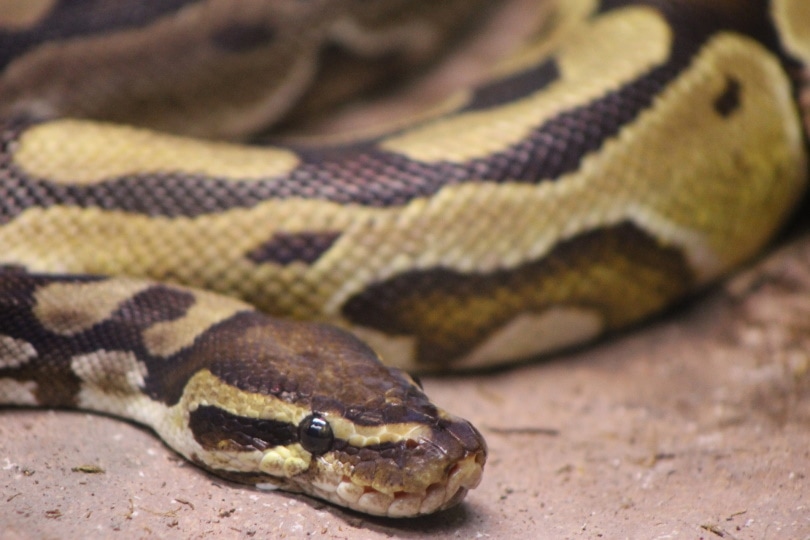
In general, lesser ball pythons tend to stay healthy so long as their habitat is clean and they’re getting the right amount of food. There are a couple of common health issues to look out for if you notice that your snake is acting funny.
Common Health Issues
Mouth rot is one of the most common issues that snake owners experience. Mouth rot is an illness that occurs when debris or food gets stuck in an injured mouth. Signs of mouth rot are bright red spots on their gums, yellow substance coming from their mouth, or excessive salivation.
Parasites are another issue you might face while owning a snake. Have your python’s stool tested by a vet if you suspect that they have parasites like pinworms, hookworms, or tapeworms.
Mites are attracted to snakes like they are to cats and dogs. The best way to keep these away from your pet is to keep their cage clean and check their bodies from small bites on a regular basis.
Are Lesser Ball Pythons Friendly? Our Handling Advice
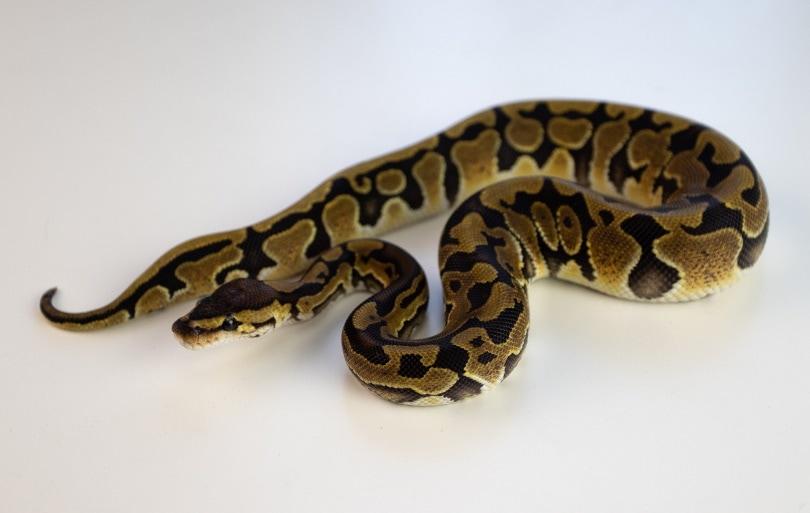
Lesser ball pythons are a little shy and spend most of their time hiding in the enclosure. At first, they could see you as a threat, but over time they will grow to trust you the more you handle them.
Support your ball python’s body and always avoid moving too quickly or you could care them. Once these snakes learn that you aren’t going to hurt them, they seem to enjoy being handled by their owner. There is occasionally a snake that has too much fear and could try to bite you, but this is why learning how to handle them from the beginning is so important. Do not handle your snake 24 hours after they eat because it could be uncomfortable for them and make them regurgitate their last meal.
Care Guide Summary
Lesser Ball Python Pros
- Docile nature
- Low-maintenance
- Simple diet
Lesser Ball Python Cons
- Must be housed individually
- Takes time to adjust to new surroundings
- Have to gain trust to handle them

Conclusion
Snakes were once a taboo pet to have, but in our modern world, people are starting to see how fun these animals are as pets. Their unique coloring and docile nature allow reptile lovers to always have them around without facing the dangers of some other snakes in captivity. If you’ve been considering bringing a snake into your home, starting with a lesser ball python is a smart choice.
Featured Image Credit: Deb Davis, Shutterstock
Kristin is passionate about helping pet parents create a fulfilling life with their pets by informing them on the latest scientific research and helping them choose the best products for their pets. She currently resides in Tennessee with four dogs, three cats, two fish, and a lizard, though she has dreams of owning chickens one-day!







